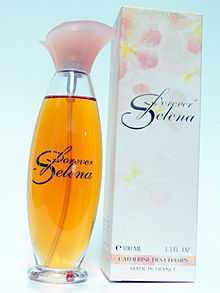Forever (Selena fragrance)
| Forever | |
|---|---|
 | |
| Fragrance by Selena | |
| Type | Women's fragrance |
| Released | September 1996 |
| Label | Catherine Des Champs/Q-Productions |
| Tagline | Forever Is, Forever Selena |
| Successor | Como La Flor |
| Website | http://q-productions.com |
Forever (also known as Selena Forever) is a women's fragrance from Catherine Des Champs, and is the first fragrance to be endorsed by Selena, which was released posthumously. Originally, the perfume was going to be released simultaneously with her crossover album. The perfume's production was delayed several times due to the on-going Amor Prohibido Tour, fashion shows for Selena Etc., recording sessions for her crossover album, and when Yolanda Saldivar stole samples for Selena to choose from.
Selena demanded Saldivar to return the samples, which failed when Saldivar murdered Selena at the Days Inn motel. The perfume was then released after her death and sold over 350,000 bottles in the United States and Mexico, prompting the Selena perfume line.
Background and Inspiration
In January 1995, Selena approached Leonard Wong, a Chinese-Mexican who set up a company to market products by direct sales to the Hispanic community, with an idea to start the Selena perfume line.[1] Selena decided that she wanted to start her own perfume line, which was to be released simultaneously with her crossover album, Dreaming of You. Gathering inspiration from her idols, Selena wanted a perfume that was "sweet, and good to smell". Selena's release and production of the perfume continually was delayed due to her on-going Amor Prohibido Tour, recording sessions for her crossover album, fashion shows for her Selena Etc. store, and a then, growing problem with Yolanda Saldivar who was embezzling money from the official Selena Fan Club.[1]
Controversary
In mid-March 1995, Saldivar stole all samples that Selena had to choose from to begin the production of her perfume, which Selena didn't find out until a week afterwards. On the morning of March 31, 1995, to retrieve paperwork and missing documents, Selena drove to Days Inn hotel and demanded the missing financial papers. Saldívar delayed the handover by claiming she had been raped in Mexico.[2] The singer drove Saldívar to Doctors Regional Hospital where doctors found no evidence of rape.[3] Saldívar returned to the motel where Selena again demanded the missing financial papers.[4]
Selena told Saldívar that she could not be trusted anymore.[5] At 11:49 am, Saldívar drew a gun from her purse, pointing it at Selena.[5] As the singer turned and left the room, Saldívar shot her once on the right lower shoulder, severing a major artery which led from Selena's heart, resulting in a massive blood loss.[5] Selena ran to the hotel lobby and collapsed. She was then transported to Corpus Christi Memorial Hospital, where she died at 1:05 p.m.
Design and Production
Leonard Wong and Abraham Quintanilla Jr, the father of Selena, decided to release the perfume in memory of Selena.[1] Quintanilla decided to sell the perfume at his recording studio store Q-Productions first, and after successful sales, Suzette Quintanilla, sister of Selena, was put in charge of sales. Suzette helped promote the perfume to Sears, Wal-Mart, and other perfume stores.
Sales
| Country | Sales |
|---|---|
| United States | 250,000[6] |
| Mexico | 100,000[6] |
See also
- Selena products
References
- ↑ 1.0 1.1 1.2 Patoski, Joe (1997). Selena: Como La Flor. Berkley Pub Group. p. 172. ISBN 978-1-57297-246-9. Retrieved 16 May 2011.
- ↑ Mitchell, Rick. "Selena". Houston Chronicle, May 21, 1995. Retrieved on February 1, 2008.
- ↑ "October 12, 1995 testimony of Carla Anthony". Houston Chronicle, October 12, 1995. Retrieved on May 21, 2008.
- ↑ Sam Howe Verhovek (April 1, 1995). "Grammy Winning Singer Selena Killed in Shooting at Texas Motel". The New York Times. p. 1.
- ↑ 5.0 5.1 5.2 "Famous Crime Scene". Season 1 (in English). 12 March 2010. 30 minutes in. VH1. More than one of
|season=and|seriesno=specified (help); Missing or empty|title=(help) - ↑ 6.0 6.1 Ruiz, Geraldo (1995). Selena: The Last Song. Warner Pub Service/El Diario Books. p. 256. ISBN 978-1-887599-01-6. Retrieved 16 May 2011.
| ||||||||||||||||||||||||||||||||||||||||||||||||||